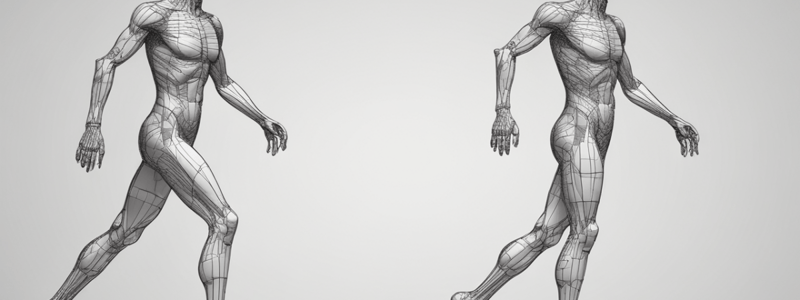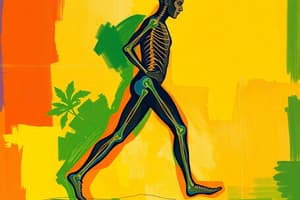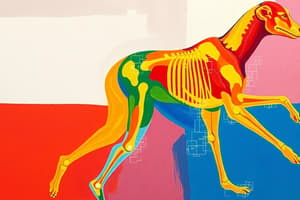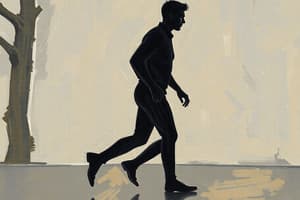Podcast
Questions and Answers
What is the direction of the horizontal force at toe off?
What is the direction of the horizontal force at toe off?
- Variable
- Positive (correct)
- Negative
- Zero
What does the double support phase indicate on a diagram?
What does the double support phase indicate on a diagram?
- Jogging
- Walking (correct)
- Running
- Sprinting
What is the name of the phase when the center of gravity is moving over the stance limb?
What is the name of the phase when the center of gravity is moving over the stance limb?
- Propulsion
- Arrest
- Push off rate (correct)
- Weight acceptance
What is the term for the upward deceleration of the center of gravity?
What is the term for the upward deceleration of the center of gravity?
What is the term for the upward acceleration of the center of gravity?
What is the term for the upward acceleration of the center of gravity?
What is the term for the horizontal force that occurs during the change of direction?
What is the term for the horizontal force that occurs during the change of direction?
What happens to the trunk during the initial swing period?
What happens to the trunk during the initial swing period?
During the terminal swing period, what happens to the knee?
During the terminal swing period, what happens to the knee?
What is the direction of the force vector during the initial swing period?
What is the direction of the force vector during the initial swing period?
What happens to the ankle during the initial swing period?
What happens to the ankle during the initial swing period?
At the end of the first double support period, what is the position of the pelvis?
At the end of the first double support period, what is the position of the pelvis?
How is the hip angle measured in the sagittal plane?
How is the hip angle measured in the sagittal plane?
During mid stance, what is the direction of the force vector?
During mid stance, what is the direction of the force vector?
What happens to the foot during the terminal swing period?
What happens to the foot during the terminal swing period?
What is the movement of the tibia during ankle dorsiflexion?
What is the movement of the tibia during ankle dorsiflexion?
What is the rotation of the tibia during foot pronation?
What is the rotation of the tibia during foot pronation?
During terminal stance, what is the period from ipsilateral heel off to contralateral foot contact also called?
During terminal stance, what is the period from ipsilateral heel off to contralateral foot contact also called?
What is the movement of the knee during mid stance?
What is the movement of the knee during mid stance?
What is the direction of the force vector at the ankle during mid-stance?
What is the direction of the force vector at the ankle during mid-stance?
What is the hip's moment during terminal stance?
What is the hip's moment during terminal stance?
What is the knee's moment during mid-stance?
What is the knee's moment during mid-stance?
What is the ankle's power pattern during terminal swing?
What is the ankle's power pattern during terminal swing?
What is the hip's power pattern during initial swing?
What is the hip's power pattern during initial swing?
What is the primary function of the glute max and hamstrings during the gait cycle?
What is the primary function of the glute max and hamstrings during the gait cycle?
What can be inferred from plantar pressure during gait?
What can be inferred from plantar pressure during gait?
What is the role of the quads during the gait cycle?
What is the role of the quads during the gait cycle?
What is the function of muscle activity (EMG) measurement?
What is the function of muscle activity (EMG) measurement?
What forces can the Achilles tendon experience during the gait cycle?
What forces can the Achilles tendon experience during the gait cycle?
What changes with increasing speed during the gait cycle?
What changes with increasing speed during the gait cycle?
Gait is the pattern of movement that allows an animal to move across a ______ substrate.
Gait is the pattern of movement that allows an animal to move across a ______ substrate.
There are five types of locomotion, including crawling, walking, running, ______, and skipping.
There are five types of locomotion, including crawling, walking, running, ______, and skipping.
The gait cycle consists of two main phases: the ______ phase and the swing phase.
The gait cycle consists of two main phases: the ______ phase and the swing phase.
The initial contact of the foot with the ground is also known as the ______ strike.
The initial contact of the foot with the ground is also known as the ______ strike.
At a speed of 5m/s, the gait cycle consists of ______% stance and 70% swing.
At a speed of 5m/s, the gait cycle consists of ______% stance and 70% swing.
Step length is the distance of the leading leg during the ______ phase.
Step length is the distance of the leading leg during the ______ phase.
Stride velocity (m/s) = stride length (m)/ _______________ (s) = stride length (m) x stride frequency (Hz)
Stride velocity (m/s) = stride length (m)/ _______________ (s) = stride length (m) x stride frequency (Hz)
The term _______________ is used to describe the mechanics of the opposite limb.
The term _______________ is used to describe the mechanics of the opposite limb.
During initial contact, the foot is in a _______________ position.
During initial contact, the foot is in a _______________ position.
During loading response, the foot starts to _______________ and tibial internal rotation occurs.
During loading response, the foot starts to _______________ and tibial internal rotation occurs.
During initial contact, the knee will be _______________ and the hip will be flexed.
During initial contact, the knee will be _______________ and the hip will be flexed.
The vertical force curve changes the most with increasing ______.
The vertical force curve changes the most with increasing ______.
At the initial contact, the trunk is positioned _______________ the leading foot, crossing the midline towards the stance leg.
At the initial contact, the trunk is positioned _______________ the leading foot, crossing the midline towards the stance leg.
During downhill running, the impact peak becomes ______ and the active peak gets smaller.
During downhill running, the impact peak becomes ______ and the active peak gets smaller.
The direction of the force F7 is in the ______ direction.
The direction of the force F7 is in the ______ direction.
During uphill running, there is a more ______ active peak and greater propulsive forces.
During uphill running, there is a more ______ active peak and greater propulsive forces.
There is a flexion moment at the ______ joint during initial contact.
There is a flexion moment at the ______ joint during initial contact.
During the initial swing period, the trunk moves to the _______________ side.
During the initial swing period, the trunk moves to the _______________ side.
The hip reaches its most _______________ position during the initial swing period.
The hip reaches its most _______________ position during the initial swing period.
During the initial swing period, the ankle is in a _______________ position.
During the initial swing period, the ankle is in a _______________ position.
During the terminal swing period, the trunk moves from maximal displacement on the left side back toward the _______________.
During the terminal swing period, the trunk moves from maximal displacement on the left side back toward the _______________.
The hip angle is measured as the thigh segment angle minus the _______________ segment angle.
The hip angle is measured as the thigh segment angle minus the _______________ segment angle.
The trunk segment angle is measured from the greater trochanter of the femur bone through to the _______________ crest.
The trunk segment angle is measured from the greater trochanter of the femur bone through to the _______________ crest.
The goal of locomotion is to support the body against gravity whilst moving forward in the plane of ______.
The goal of locomotion is to support the body against gravity whilst moving forward in the plane of ______.
Plantar pressure indirectly reflects the accelerations of all ______ parts as we walk.
Plantar pressure indirectly reflects the accelerations of all ______ parts as we walk.
From triceps surae (gastroc and soleus) Propulsion Phase H2: ______ flexor power absorption (eccentric).
From triceps surae (gastroc and soleus) Propulsion Phase H2: ______ flexor power absorption (eccentric).
From rectus femoris, the Knee extensor power ______ (eccentric) during the Swing Phase.
From rectus femoris, the Knee extensor power ______ (eccentric) during the Swing Phase.
The sources of power generation for forward propulsion provides insight on the strategy of ______.
The sources of power generation for forward propulsion provides insight on the strategy of ______.
Muscle Activity (EMG) gives an overall perspective of when muscles are turned ______ and off.
Muscle Activity (EMG) gives an overall perspective of when muscles are turned ______ and off.
Flashcards are hidden until you start studying
Study Notes
Gait Kinetics and Kinematics
Ground Reaction Forces
- At mid-stance, there's a vertical force acting upwards, and horizontal force is 0.
- At toe-off, there's a positive vertical force acting upwards and a positive horizontal force acting in the direction of travel.
- Vertical force curve has a 2-hill shape for constant velocity walking, with both hills equal in magnitude.
- Double support phase indicates walking, not running.
Phases of Gait Cycle
- Initial Contact (Heel Strike)
- Trunk: behind leading foot, crossing midline towards the stance leg
- Hip: flexed
- Knee: extended, starting to flex
- Ankle: neutral
- Foot: supinated
- Loading Response
- Start of the double support period
- Body has traveled over the supporting leg
- Force vector passes through the heel, knee, and is in front of the pelvis
- Trunk: lowest vertical position, moving laterally towards the stance leg
- Hip: extending
- Knee: flexing
- Ankle: plantarflexing
- Foot: pronating and tibial internal rotation
- Mid-Stance
- Weight has shifted forwards to the middle of the foot
- Force vector passes through the middle of the foot, knee, and stance leg
- Only vertical force at this point
- Trunk: highest point, peak lateral motion
- Hip: extending
- Knee: peak flexion, begins to extend
- Ankle: dorsiflexing
- Foot: supinated and tibial external rotation
- Terminal Stance
- Second double support phase
- Heel leaves the ground, and propulsion and horizontal forces occur
- Ankle: moving from negative to positive
- Hip: extension moment
- Knee: flexion moment
- Initial Swing
- Force vector passes through the last point of the toe and in the direction of forwards and upwards
- Trunk: moving towards the new supporting foot, gaining height
- Hip: flexing
- Knee: flexing (mainly due to hip flexion)
- Ankle: moving from plantarflexion to neutral or dorsiflexion
- Foot: slightly supinated
- Terminal Swing
- Trunk: moving back towards the midline, losing height
- Hip: flexing (rate of flexion decreasing)
- Knee: rapid knee extension (mostly passive)
- Ankle: neutral
- Foot: remains in supination
Joint Power Patterns
- Braking Phase
- Hip: extensor power generation (concentric)
- Knee: flexor power absorption (eccentric)
- Ankle: power absorption (eccentric)
- Propulsion Phase
- Hip: flexor power absorption (eccentric)
- Ankle: plantarflexion power generation (concentric)
- Knee: extensor power absorption (eccentric)
- Swing Phase
- Hip: flexor power generation (concentric)
- Knee: extensor power absorption (eccentric)
- Knee: extensor power generation (concentric)
Gait Velocity
- Stride velocity (m/s) = stride length (m) / stride time (s)
- Stride velocity (m/s) = stride length (m) x stride frequency (Hz)
Key Kinematics
- Sagittal Plane Kinematics
- Hip angle: thigh segment angle - trunk segment angle
- Trunk angle: from the greater trochanter of the femur bone to the iliac crest
Frontal and Transverse Plane Kinetics
- Goal of locomotion: to support the body against gravity while moving forward in the plane of progression
- Need full 3D motion analysis
Plantar Pressure
- Indirectly reflects accelerations of all body parts as we walk
- Will be unique to everyone
- Often look at peak pressure in zones of the foot
- Modified Arch Index (MAI) and COP Excursion Index (CPI)
Muscle Activity (EMG)
- Gives an overall perspective of when muscles are turned on and off
- Activity of all muscles go towards propulsion and breaking during the gait cycle
- Achilles can experience up to 6-8 x BW in forces through it
Energy Source
- Sources of power generation for forward propulsion provide insight into the strategy of movement
- Hips are powerful extensors during the second half, while knee flexors are for the first
- Movement strategy changes with increasing speed
Studying That Suits You
Use AI to generate personalized quizzes and flashcards to suit your learning preferences.




